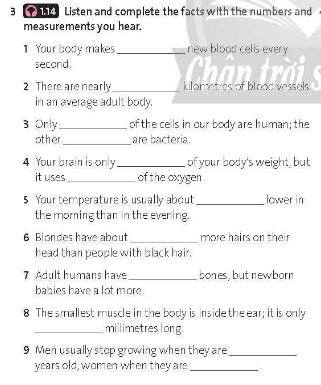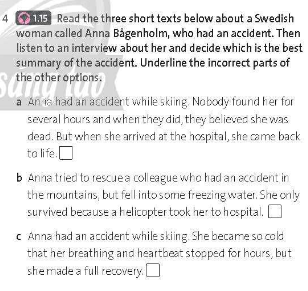Friends Global 11 Workbook Unit 3 3C Listening
Workbook Tiếng Anh 11 Unit 3 3C Listening trang 26
Giải bài tập SBT tiếng Anh 11 Friends Global Unit 3 3C Listening trang 26 hướng dẫn giải chi tiết các phần bài tập trong Sách bài tập tiếng Anh lớp 11 Friends Global giúp các em học sinh chuẩn bị bài tập tại nhà hiệu quả.
1. Read the Listening Strategy. Then listen and circle the number or measurement you hear.
(Đọc chiến lược nghe. Sau đó nghe và khoanh tròn số đếm hoặc số đo mà bạn nghe được.)
Bài nghe

Gợi ý đáp án
|
1. c |
2. a |
3. a |
4. c |
5. b |
6. c |
7. c |
8. a |
Nội dung bài nghe
1. a hundred and fifty thousand. (150,000)
2. three million seven hundred thousand (3,700,000)
3. two point zero seven (2,07)
4. three tenth (3/10)
5. thirty-point five percent (30.5%)
6. twenty to twenty-five (20 - 25)
7. minus twenty-five degee Celsius (-25°C)
8. nineteen thirty (1930)
2. Read aloud all the numbers and measurements in exercise 1
(Đọc to tất cả số đếm và số đo ở bài 1)
3. Listen and complete the facts with the numbers and measurements you hear.
(Nghe và hoàn thành dữ kiện với số đếm và số đo bạn nghe thấy)
Bài nghe
 Gợi ý đáp án
Gợi ý đáp án
|
1. 2 million |
2. 100,000 |
3. 10%, 90% |
|
4. 2%, 1/5 |
5. 0.50C |
6. 30,000 |
|
7. 206 |
8. 1.27 |
9. 20-22; 15-16 |
Nội dung bài nghe
Nội dung bài nghe
1. Your body makes 2 million new blood cells every second.
(Cơ thể bạn tạo ra 2 triệu tế bào máu mới mỗi giây.)
2. There are nearly 100,000 kilometres of blood vessels in an average adult body.
(Cơ thể người trưởng thành trung bình có gần 100.000 km mạch máu.)
3. Only 10% of the cells in our body are human; the other 90% are bacteria.
(Chỉ 10% tế bào trong cơ thể chúng ta là của con người; 90% còn lại là vi khuẩn.)
4. Your brain is only 2% of your body’s weight, but it uses 1/5 of the oxygen.
(Bộ não của bạn chỉ nặng bằng 2% trọng lượng cơ thể nhưng sử dụng 1/5 lượng oxy.)
5. Your temperature is usually about 0.5°C lower in the morning than in the evening.
(Nhiệt độ của bạn thường thấp hơn vào buổi sáng khoảng 0,5°C so với buổi tối.)
6. Blondes have about 30,000 more hairs on their head than people with black hair.
(Những người tóc vàng có nhiều hơn khoảng 30.000 sợi tóc trên đầu so với những người có mái tóc đen.)
7. Adult humans have 206 bones, but newborn babies have a lot more.
(Người trưởng thành có 206 chiếc xương, nhưng trẻ sơ sinh có nhiều hơn thế.)
8. The smallest muscle in the body is inside the ear; it is only 1.27 millimetres long.
(Cơ nhỏ nhất trong cơ thể nằm ở bên trong tai; nó chỉ dài 1,27 mm.)
9. Men usually stop growing when they are 20–22 years old, women when they are 15–16.
(Đàn ông thường ngừng phát triển khi ở độ tuổi 20–22, phụ nữ ở độ tuổi 15–16.)
4. Read the three short texts below about a Swedish woman called Anna Bagenholm, who had an accident. Then listen to an interview about her and decide which is the best summary of the accident. Underline the incorrect parts of the other options.
(Đọc ba đoạn văn ngắn dưới đây về một người phụ nữ Thụy Điển tên là Anna Bagenholm, người bị tai nạn. Sau đó hãy nghe một cuộc phỏng vấn về cô ấy và quyết định đâu là bản tóm tắt hay nhất về vụ tai nạn. Gạch chân những phần sai trong các lựa chọn khác.)
Bài nghe

Gợi ý đáp án
Summary is correct
The incorrect parts of the other options are
a. Nobody found her for several hours. When she arrived at the hospital, she came back to life.
b. Anna tried to rescue a colleague who had an accident in the mountains.
Nội dung bài nghe
Interviewer: You have been looking at how the human body copes with very low temperatures. Is that right?
Scientist: Yes, that’s right.
Interviewer: And what have you found?
Scientist: Well, it’s an interesting question. Of course, freezing temperatures are bad for the body. You can get frostbite if your skin freezes. And about two thirds of people whose body temperature falls below 28° Celsius actually die. But at the same time, there are some people who have survived much lower body temperatures – and made a full recovery.
Interviewer: Can you give us an example?
Scientist: Yes. There’s the famous case of a Swedish doctor called Anna Bågenholm. She was skiing in the mountains in Norway when she had an accident.
Interviewer: How did the accident happen?
Scientist: Well, she went skiing with two colleagues from hospital – Anna was a doctor, you see, and was studying to become a surgeon. Anyway, the three of them were skiing down a steep mountain when Anna lost control of her skis. She fell onto a sheet of ice, which was actually the surface of a stream. The ice broke and Anna fell headfirst through the hole, as far as her waist. Beneath the ice was water, freezing cold water.
Interviewer: What did her two friends do?
Scientist: Well, they tried to pull her out by her legs – but she was trapped under the ice. She could breathe, because there was some air between the ice and the water, but she couldn’t move. After trying for seven minutes to free her, her two colleagues gave up and phoned for help.
Interviewer: And did help arrive quickly?
Scientist: Two rescue teams set off to help Anna, one from the top of the mountain and one from the bottom. The one from the top arrived first, but they couldn’t pull her out of the ice.
Interviewer: What about the second team?
Scientist: The second team managed to get her out by cutting a hole in the ice. But by the time they got her free, she had been in the freezing water for 80 minutes. Anna was not breathing and her heart was not beating. A helicopter took her to hospital. When she arrived, her body temperature was 13.7° Celsius. According to the doctor in charge of the emergency room, Anna was ice cold and looked dead.
Interviewer: But I guess she wasn’t.
Scientist: Well, no. There’s an expression among some doctors: ‘You aren’t dead until you’re warm and dead.’ In other words, sometimes people who are extremely cold can come back to life when they get warmer. Doctors at the hospital worked for nine hours to save Anna. When her temperature had risen to 36.4° Celsius, her heart started beating again. Gradually, after many weeks, Anna made a full recovery.
Interviewer: That’s amazing.
Scientist: Yes, and in 2009, ten years after the accident, Anna got a job working as a doctor in the hospital that had saved her life!
Trên đây là Unit 3 tiếng Anh lớp 11 Friends Global Workbook trang 26 đầy đủ nhất, hy vọng đây là tài liệu học tập hữu ích dành cho quý phụ huynh, thầy cô và các em học sinh.








